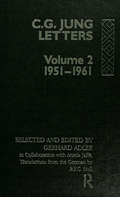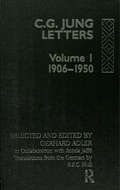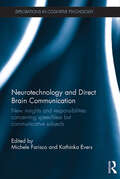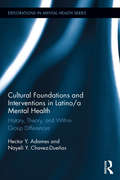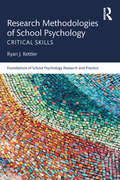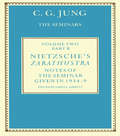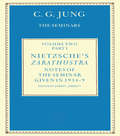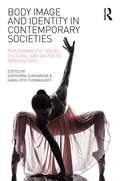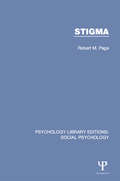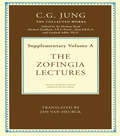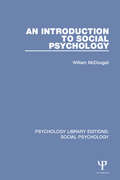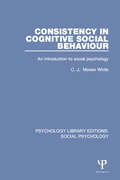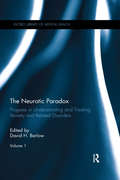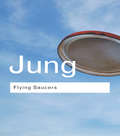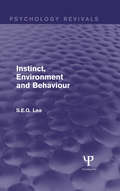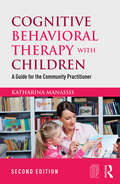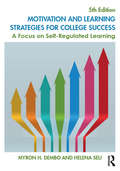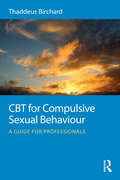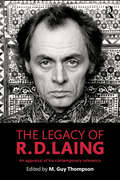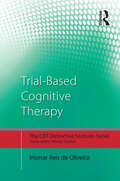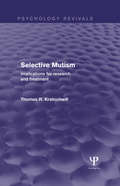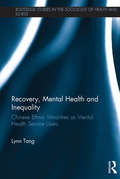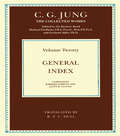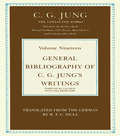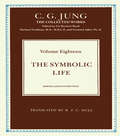- Table View
- List View
Letters of C. G. Jung: Volume 2, 1951-1961
by C.G JungIn May 1956, in his eighty-second year, Jung first discussed with Gerhard Adler the question of the publication of his letters. Over many years, Jung had often used the medium of letters to communicate his ideas to others and to clarify the interpretation of his work, quite apart from answering people who approached him with genuine problems of their own and simply corresponding with friends and colleagues. Many of his letters thus contain new creative ideas and provide a running commentary on his work.From some 1,600 letters written by Jung between the years 1906-1961, the editors have selected over 1,000. Volume 2 contains 460 letters written between 1951 and 1961, during the last years of Jung's life, when he was in contact with many people whose names are familiar to the English reader. These include Mircea Eliade, R.F.C. Hull, Ernest Jones, Herbert Read, J.B. Rhine, Upton Sinclair and Fr. Victor White.Volume 2 also contains an addenda with sixteen letters from the period 1915-1946 and a subject index to both volumes. The annotation throughout is detailed and authoritative.
Letters of C. G. Jung: Volume I, 1906-1950
by C. G. JungIn May 1956, in his eighty-second year, Jung first discussed with Gerhard Adler the question of the publication of his letters. Over many years, Jung had often used the medium of letters to communicate his ideas to others and to clarify the interpretation of his work, quite apart from answering people who approached him with genuine problems of their own and simply corresponding with friends and colleagues. Many of his letters thus contain new creative ideas and provide a running commentary on his work.From some 1,600 letters written by Jung between the years 1906-1961, the editors have selected over 1,000. Volume 1, published in 1973, contains those letters written between 1906 and 1950.
Neurotechnology and Direct Brain Communication: New insights and responsibilities concerning speechless but communicative subjects (Explorations in Cognitive Psychology)
by Michele Farisco Kathinka EversNeurotechnology and Direct Brain Communication focuses on recent neuroscientific investigations of infant brains and of patients with disorders of consciousness (DOC), both of which are at the forefront of contemporary neuroscience. The prospective use of neurotechnology to access mental states in these subjects, including neuroimaging, brain simulation, and brain computer interfaces, offers new opportunities for clinicians and researchers, but has also received specific attention from philosophical, scientific, ethical, and legal points of view. This book offers the first systematic assessment of these issues, investigating the tools neurotechnology offers to care for verbally non-communicative subjects and suggesting a multidisciplinary approach to the ethical and legal implications of ordinary and experimental practices. The book is divided into three parts: the first and second focus on the scientific and clinical implications of neurological tools for DOC patient and infant care. With reference to these developments, the third and final part presents the case for re-evaluating classical ethical and legal concepts, such as authority, informed consent, and privacy. Neurotechnology and Direct Brain Communication will appeal to researchers and postgraduate students in the fields of cognitive science, medical ethics, medical technology, and the philosophy of the mind. With implications for patient care, it will also be a useful resource for clinicians, medical centres, and health practitioners.
Cultural Foundations and Interventions in Latino/a Mental Health: History, Theory and within Group Differences (Explorations in Mental Health)
by Hector Y. Adames Nayeli Y. Chavez-DueñasAdvancing work to effectively study, understand, and serve the fastest growing U.S. ethnic minority population, this volume explicitly emphasizes the racial and ethnic diversity within this heterogeneous cultural group. The focus is on the complex historical roots of contemporary Latino/as, their diversity in skin-color and physiognomy, racial identity, ethnic identity, gender differences, immigration patterns, and acculturation. The work highlights how the complexities inherent in the diverse Latino/a experience, as specified throughout the topics covered in this volume, become critical elements of culturally responsive and racially conscious mental health treatment approaches. By addressing the complexities, within-group differences, and racially heterogeneity characteristic of U.S. Latino/as, this volume makes a significant contribution to the literature related to mental health treatments and interventions.
Research Methodologies of School Psychology: Critical Skills (Foundations of School Psychology Research and Practice)
by Ryan J. KettlerResearch Methodologies of School Psychology is a comprehensive, actionable resource that offers graduate students and school psychologists the knowledge and skills to apply key scientific techniques in practice. A volume in the Foundations of School Psychology Research and Practice Series, this book directly addresses the need for definitive resources on mastering research methodologies in the field. Covering topics such as development and evaluation of measures, application of various designs, and drawing inferences from data, Ryan J. Kettler provides rigorous yet accessible methodological guidance. Each chapter includes illustrative examples, summaries of essential learnings, and reflective concluding questions. Using these engaging and invaluable strategies, graduate students and school psychologists will be effectively prepared to apply the scientific method in their own professional contexts.
Nietzsche's Zarathustra: Notes of the Seminar given in 1934-1939 by C.G. Jung (Bollingen Series (general) Ser. #600)
by C. G. JungFirst published in 1989. Routledge is an imprint of Taylor & Francis, an informa company.
Nietzsche's Zarathustra: Notes of the Seminar given in 1934-1939 by C.G.Jung (Bollingen Series (general) Ser. #600)
by C. G. JungAs a young man growing up near Basel, Jung was fascinated and disturbed by tales of Nietzsche's brilliance, eccentricity, and eventual decline into permanent psychosis. These volumes, the transcript of a previously unpublished private seminar, reveal the fruits of his initial curiosity: Nietzsche's works, which he read as a student at the University of Basel, had moved him profoundly and had a life-long influence on his thought. During the sessions the mature Jung spoke informally to members of his inner circle about a thinker whose works had not only overwhelmed him with the depth of their understanding of human nature but also provided the philosophical sources of many of his own psychological and metapsychological ideas. Above all, he demonstrated how the remarkable book Thus Spake Zarathustra illustrates both Nietzsche's genius and his neurotic and prepsychotic tendencies.Since there was at that time no thought of the seminar notes being published, Jung felt free to joke, to lash out at people and events that irritated or angered him, and to comment unreservedly on political, economic, and other public concerns of the time. This seminar and others, including the one recorded in Dream Analysis, were given in English in Zurich during the 1920s and 1930s.
Body Image and Identity in Contemporary Societies: Psychoanalytic, social, cultural and aesthetic perspectives
by Ekaterina Sukhanova Hans-Otto ThomashoffPopular interest in body image issues has grown dramatically in recent years, due to an emphasis on individual responsibility and self-determination in contemporary society as well as the seemingly limitless capacities of modern medicine; however body image as a separate field of academic inquiry is still relatively young. The contributors of Body Image and Identity in Contemporary Societies explore the complex social, political and aesthetic interconnections between body image and identity. It is an in-depth study that allows for new perspectives in the analysis of contemporary visual art and literature but also reflects on how these social constructs inform clinical treatment. Sukhanova and Thomashoff bring together contributions from psychoanalysts, psychotherapists, psychiatrists and scholars in the fields of the social sciences and the humanities to explore representations of the body in literature and the arts across different times and cultures. The chapters analyse the social construction of the 'ideal' body in terms of beauty, gender, sexuality, race, ethnicity, class and disability, from a broadly psychoanalytic perspective, and traces the mechanisms which define the role of the physical appearance in the formation of identity and the assumption of social roles. Body Image and Identity in Contemporary Societies' unique interdisciplinary outlook aims to bridge the current gap between clinical observations and research in semiotic theory. It will be of interest to psychoanalysts, psychotherapists, art therapists, art theorists, academics in the humanities and social sciences, and those interested in an interdisciplinary approach to the issues of body image and identity. Ekaterina Sukhanova is University Director of Academic Program Review at the City University of New York USA. She serves as Scientific Secretary of the Section for Art and Psychiatry and the Section of Art and Psychiatry of the World Psychiatric Association. She is also engaged in interdisciplinary research on cultural constructs of mental health and illness and curates exhibits of art brut as a vehicle for fighting stigma. Hans-Otto Thomashoff was born in Germany and lives in Vienna. He is a psychiatrist, psychoanalyst, art historian and author of fiction and non-fiction books. He has been curator of several art exhibitions highlighting the connection between the psyche and art as well as president of the section of Art and Psychiatry of the World Psychiatric Association and advisory committee member of the Sigmund Freud Foundation, Vienna.
Stigma (Psychology Library Editions: Social Psychology)
by Robert M. PageAlthough references to stigma were commonplace in the field of social policy and elsewhere, the concept was often used in a rather imprecise way. Originally published in 1984, this book assesses the relevance of the concept of stigma for the study of social policy. Investigations of the concept within the welfare field have tended to be far too narrow in focus (i.e. the concept has been regarded as a technical problem which can be eradicated by greater adherence to the principle of universalism). As a counter to this perspective, Robert Page argues that it is necessary to distinguish much more clearly between various aspects of the concept of stigma (e.g. stigmas, stigmatization and felt stigma). He examines the reasons why, and the ways in which, one particular ‘welfare’ group – unmarried mothers – have been stigmatized over the centuries in order to highlight the importance of examining existing patterns of ‘welfare’ and other forms of stigmatization within their political, economic, social and historical context. It is concluded that stigma will continue to be a key concept for both students and practitioners within the field of social policy provided that it is examined from this wider perspective.
The Zofingia Lectures: Supplementary Volume A (Collected Works of C. G. Jung #1)
by C.G. JungThe Zofingia Club was a discussion group to which C.G. Jung belonged as a medical student: in 1897 he became Chairman, and gave five lectures. These have survived and are published here in a supplementary volume to the Collected Works. The lectures are of great interest to anyone concerned with Jung's early ideas, as a young medical student from a strongly Swiss Protestant background. The Lectures are: The Border Zones of Exact Science (November 1896); Some Thoughts on Psychology (May 1897); An Inaugural Address on Becoming Chairman of the Zofingia Club; Thoughts on the Nature and Value of Speculative Inquiry (Summer 1898); and Thoughts on the Interpretation of Christianity with Reference to the Theory of Albrecht Ritschl (January 1899).
An Introduction to Social Psychology (Psychology Library Editions: Social Psychology)
by William McDougallOn its first publication in 1908 this pioneer book received immediate acclaim and was thought to have probably done more than any other single publication to stimulate study of the foundations of social behaviour. Professor McDougall was the most powerful advocate of an idealistic outlook on human life and activity, and his ideas continued to attract attention even when published in paperback form in 1960.
Consistency in Cognitive Social Behaviour: An introduction to social psychology (Psychology Library Editions: Social Psychology)
by C.J. Mower WhiteSocial psychology remains unbalanced as long as we study human behaviour exclusively ‘from the outside’, leaving out of account people’s own reasons for acting as they do. Originally published in 1982, the result of the author’s emphasis on the cognitive dimension is a much more complete and well-rounded textbook of social psychology than had previously been available. Beginning with an exploration of the various models that have been suggested to explain the whole range of social behaviour, the book goes on to argue that consistency – comparability, similarity, congruity – is the principle by which social behaviour can best be explained. It goes into the cognitive processes that determine social attitudes, ascription of certain characteristics to individuals, and the attraction we feel to some people but not others. It also shows how these processes can be extended and affected by group membership. Consistency is important, the author believes, because it allows the maximum prediction of others’ behaviour and guidance of our own. These functions are demonstrated by observing failures of consistency, such as occur in humour and in negative self-esteem, and the author examines these inconsistencies in a final chapter.
The Neurotic Paradox, Volume 1: Progress in Understanding and Treating Anxiety and Related Disorders (World Library of Mental Health)
by David H. BarlowThis collection of David H. Barlow‘s key papers are a testimony to the collaborative research that he engendered and directed with associates who now stand with him at the forefront of experimental psychopathology research and in the treatment of anxiety and related disorders. His research on the nature of anxiety and mood disorders resulted in new conceptualizations of etiology and classification. This research led new treatments for anxiety and related emotional disorders, most notably a new transdiagnostic psychological approach that has been positively evaluated and widely accepted. Clinical psychology will benefit from this collection of papers with connecting commentary.
Flying Saucers: A Modern Myth of Things Seen in the Sky (Routledge Classics)
by C.G. JungWritten in the late 1950s at the height of popular fascination with UFO's, Flying Saucers is the great psychologist's brilliantly prescient meditation on the phenomenon that gripped the world. A self-confessed sceptic in such matters, Jung was nevertheless intrigued, not so much by their reality or unreality, but by their psychic aspect. He saw flying saucers as a modern myth in the making, to be passed down the generations just as we have received such myths from our ancestors. In this wonderful and enlightening book Jung sees UFO's as 'visionary rumours', the centre of a quasi-religious cult and carriers of our technological and salvationist fantasies. 40 years later, with entire religions based on the writings of science fiction authors, it is remarkable to see just how right he has proved to be.
Instinct, Environment and Behaviour (Psychology Revivals)
by Stephen LeaWhat can the evolution of animal behaviour tell us about human behaviour? More specifically, how good an account of animal behaviour can we give in terms of evolution, and how do humans fit in with or deviate from the pattern established for other animals? The biological approach to the study of animal behaviour has important implications for psychology, but it is distinctly different. Originally published in 1984, this book provides a basic introduction to biological theories about behaviour, from the classic ethological tradition of Lorenz and Tinbergen to the later sociobiological approach. The principles of experimentation and research involved are assessed critically, especially with regard to their implications for the study of human behaviour. Written specifically for those with little biological knowledge, this book will still be of interest to students of biology and introductory psychology alike.
Cognitive Behavioral Therapy with Children: A Guide for the Community Practitioner
by Katharina ManassisThis new edition of Cognitive Behavioral Therapy with Children links together the methods of cognitive behavioral therapy (CBT) practiced in academic centers as well as the community. This book addresses the challenges community practitioners face when pressured to use CBT with youth who live with mental health disorders, but whose circumstances differ from those in research settings. Practitioners will learn how to overcome therapeutic obstacles. This new edition contains an expanded discussion on cultural considerations relevant to assessment and treatment, as well as a new chapter on training others in CBT for children.
Motivation and Learning Strategies for College Success: A Focus on Self-Regulated Learning
by Myron H. Dembo Helena SeliCombining theory, research, and applications, this popular text guides college students on how to become self-regulated learners. Students gain knowledge about human motivation and learning as they improve their study skills. The focus is on relevant information and features to help students to identify the components of academic learning that contribute to high achievement, to master and practice effective learning and study strategies, and then to complete self-regulation studies that teach a process for improving their academic behavior. A framework organized around motivation, methods of learning, time management, control of the physical and social environment, and monitoring performance makes it easy for students to recognize what they need to do to become academically more successful. Pedagogical features include Exercises, Follow-Up Activities, Student Reflections, Chapter-end Reviews, Key Points, and a Glossary. New in the Fifth Edition Discussion of the importance of sleep in learning and memory Revised and updated chapter on self-regulation of emotions Current research on impact of students’ use of technology including digital learning platforms and tools, social media, and online learning Updated Companion Website resources for students and instructors
CBT for Compulsive Sexual Behaviour: A guide for professionals
by Thaddeus BirchardIncreasing numbers of therapists are coming into contact with the problem of compulsive sexual behaviour disorders. However, it is still a relatively new field and there is little in the current literature available that enables the therapist to work with and treat this problem. CBT for Compulsive Sexual Behaviour: A guide for professionals addresses this by providing a guide to cognitive-behavioural theory and practice which includes the assessment, diagnosis and treatment of addictive sexually compulsive disorders. Beginning with a description of addictive sexuality and an overview of cognitive behavioural therapy in which CBT is presented as the most useful response, Thaddeus Birchard provides clear therapeutic information about the implementation of CBT treatment intervention. The chapters included cover the neuroscience that underpins the addictive process; a ‘how to’ chapter on the use of groups; paraphilias; trauma and attachment; comorbid disorders and cross-addictions and analysis on the function of internet pornography, all written from a cognitive behavioural stance. Using case vignettes throughout, Thaddeus Birchard draws on his own experience as a psychosexual therapist, along with the latest research in the field, to enable the therapist to treat a range of compulsive sexual problems in a way that can be applied in individual practice or in a group setting as well as how to prevent relapse. This book will be essential reading for psychosexual therapists, cognitive behaviour therapists and other professional working with sexual compulsive disorders.
The Legacy of R. D. Laing: An appraisal of his contemporary relevance
by M. Guy ThompsonThe name R. D. Laing continues to be widely recognized by those in the psychotherapy community in the United States and Europe. Laing’s books are a testament to his breadth of interests, including the understanding of madness, alternatives to conventional psychiatric treatment, existential philosophy and therapy, family systems, cybernetics, mysticism, and poetry. He is most remembered for his devastating critique of psychiatric practices, his controversial rejection of the concept of ‘mental illness,’ and his groundbreaking center for people in acute mental distress at Kingsley Hall, London. Most of the books that have been published about Laing have been written by people who did not know him personally and were unfamiliar with Laing the man and teacher. The Legacy of R. D. Laing: An appraisal of his contemporary relevance is composed by thinkers and practitioners who knew Laing intimately, some of whom worked with Laing. This collection of papers brings a perspective and balance to Laing’s controversial ideas, some of which were never addressed in his books. There has never been a collection of papers that address so thoroughly the question of who Laing was and why he became the most famous psychiatrist in the world. As M. Guy Thompson’s collection illustrates, there are now a number of alternatives to psychiatry throughout the world, and much of this can be credited to Laing’s influence. The Legacy of R. D. Laing will ensure the reader has a keen grasp of who Laing was, what it was like to be his patient or his friend, and why his thinking was far ahead of its time, even in the radical era of the 1970s. It is timely to appraise the nature of his contribution and bring Laing back into contemporary conversations about the nature of sanity and madness, and more humane approaches to helping those in profound mental distress. This book offers an in-depth insight into the work of R.D. Laing. It will be a must read for psychoanalysts, psychotherapists, family therapists, psychiatrists and academics alike. M. Guy Thompson, PhD is a Personal and Supervising Analyst at the Psychoanalytic Institute of Northern California and Chairman of Free Association, Inc., a non-profit organization devoted to the dissemination of Laing’s ideas, in San Francisco. Dr. Thompson received his psychoanalytic training from R. D. Laing and associates at the Philadelphia Association and is the author of numerous books and journal articles on psychoanalysis, phenomenology, and schizophrenia. He currently lives in San Rafael, California.
Trial-Based Cognitive Therapy: Distinctive features (CBT Distinctive Features)
by Irismar Reis de OliveiraTrial-Based Cognitive Therapy (TBCT) is a new model of cognitive behaviour therapy (CBT) that organizes standard cognitive and behavioural techniques in a step-by-step fashion, making CBT more easily mastered by the new therapist, more easily understood by the patients, and simpler to be implemented, whilst still maintaining flexibility and CBT’s recognized effectiveness. Dividing thirty key features into two parts: ‘Theory and Practice’, this concise book explores the principles of TBCT, explains the techniques developed throughout TBCT therapy to change dysfunctional cognitions, and provides a clear guide to the distinctive characteristics of TBCT. Trial-Based Cognitive Therapy will be of interest to psychiatrists, psychologists, social workers, therapists, counsellors and other professionals working in the field of mental health, plus those wanting to learn CBT. Trial-Based Cognitive Therapy is part of the Distinctive Features series, which asks leading practitioners and theorists of the main CBT therapies to highlight the main features of their particular developing approach. The series as a whole will be essential reading for psychotherapists, counsellors and psychologists of all orientations.
Selective Mutism: Implications for Research and Treatment (Psychology Revivals)
by Thomas R. KratochwillOriginally published in 1981, this title was designed to present a comprehensive review of research on, and treatment of selective mutism. It represents the only systematic overview of research and treatment procedures on this behavioral problem at the time. In many respects the literature on selective mutism clearly presents the differences in assessment and treatment between the intrapsychic (or psychodynamic) and behavioral approaches to deviant behaviour. The title presents an overview of the two major therapeutic approaches of human behaviour within the context of treating selective mutism.
Recovery, Mental Health and Inequality: Chinese Ethnic Minorities as Mental Health Service Users
by Lynn TangMental health has long been perceived as a taboo subject in the UK, so much so that mental health services have been marginalised within health and social care. There is even more serious neglect of the specific issues faced by different ethnic minorities. This book uses the rich narratives of the recovery journeys of Chinese mental health service users in the UK – a perceived ‘hard-to-reach group’ and largely invisible in mental health literature – to illustrate the myriad ways that social inequalities such as class, ethnicity and gender contribute to service users' distress and mental ill-health, as well as shape their subsequent recovery journeys. Recovery, Mental Health and Inequality contributes to the debate about the implementation of ‘recovery approach’ in mental health services and demonstrates the importance of tackling structural inequalities in facilitating meaningful recovery. This timely book would benefit practitioners and students in various fields, such as nurses, social workers and mental health postgraduate trainees.
General Index (Collected Works of C.G. Jung)
by C.G. JungThis volume is the general index to the eighteen published textual volumes in the Collected Works of C.G. Jung. The comprehensive indexing goes beyond the volume indexes, and includes sub-indexes to important general topics, such as Alchemical Collections, Codices and Manuscripts, Feud and Numbers, the sub-indexing for the Bible arranged by book, chapter and verse. The General Index, with the General Bibliography of C.G. Jung's Writings (Volume 19 of the Collected Works), together complete the publication of the Collected Works of C.G. Jung in English.
General Bibliography of C.G. Jung's Writings (Collected Works of C. G. Jung)
by C.G. JungThis bibliography records the initial publication of each original work by C.G. Jung, each translation, and significant revisions and expansions of both, up to 1975. In nearly every case, the compilers have examined the publications in German, French and English. Translations are recorded in Danish, Dutch, English, Finnish, French, Greek Hebrew, Hungarian, Italian, Japanese, Norwegian, Portuguese, Russian, Serbo-Croatian, Slovenian, Spanish, Swedish and Turkish. It is arranged according to language, with German and English first, publications being listed chronologically in each language. The General Bibliography lists the contents of the respective volumes of the Collected Works (of which this is Volume 19) and the Gesammelte Werke, published in Switzerland, and shows the interrelation of the two editions. It also lists Jung's seminars and provides, where possible, information about the origin of works that were first conceived as lectures. An index is provided of all the titles in English and German, and all original works in the other languages. Three specialist indexes, of personal names, organizations and societies and periodicals, complete the work. The publication of the General Bibliography, together with the General Index (Volume 20 of the Collected Works), complete the publication of the Collected Works of C.G. Jung in English.
The Symbolic Life: Miscellaneous Writings (Collected Works of C.G. Jung #53)
by C.G. JungOriginally planned as a brief final volume in the Collected Works, The Symbolic Life has become the most ample volume in the edition, and one of unusual interest. It contains some 160 items spanning sixty years; they include forewords, replies to questionnaires, encyclopedia articles, occasional addresses, and letters on technical subjects.Collection of this material relied on three chief circumstances. After Jung returned from active medical practice, he gave more of his time to writing, and some sixty papers as well as books were written after 1950. Second, recent research has brought to light a number of reviews, reports and articles from the early years of Jung's career. Finally, Jung's files yielded several finished or virtually finished papers that survived in manuscript. Volume 18 includes three longer works: 'The Tavistock Lectures' (1936); 'Symbols and the Interpretation of Dreams' (1961); and 'The Symbolic Life', the transcript of a seminar given in London in 1939.
